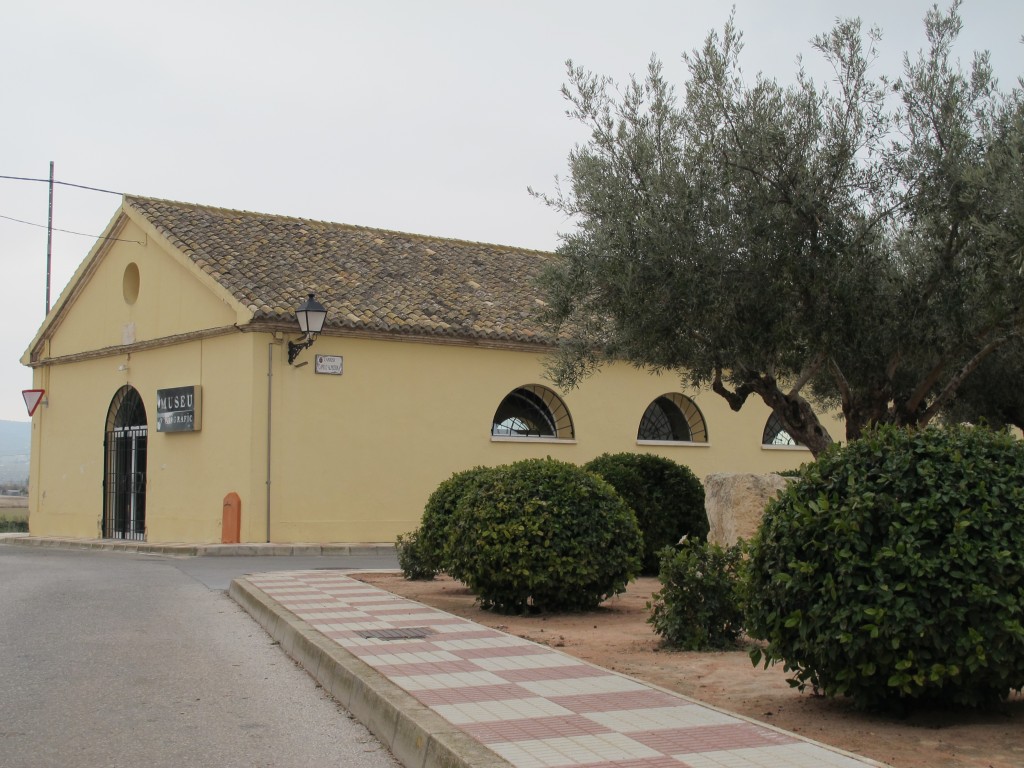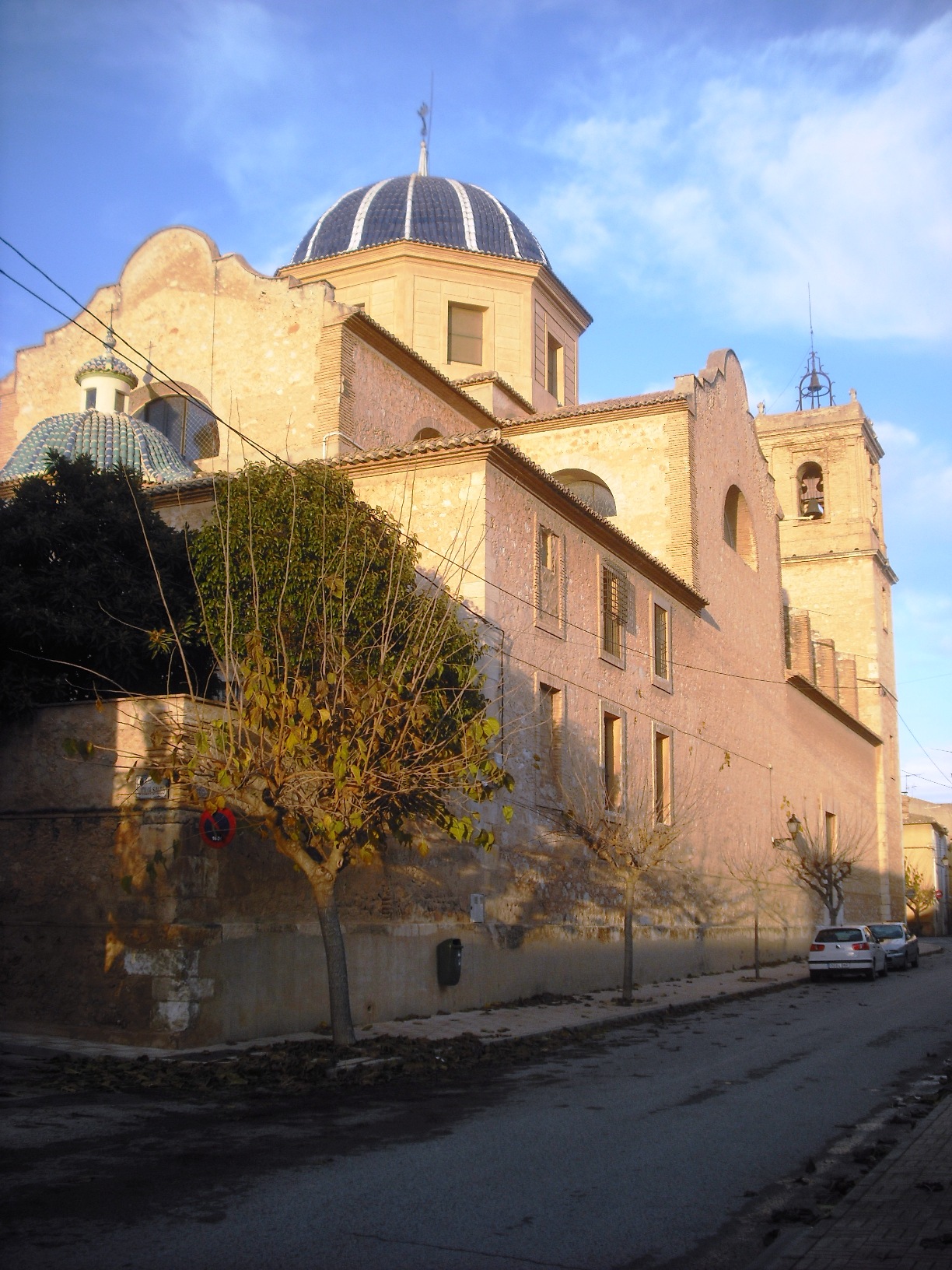Se construyó como edificio emblemático, que pudiera albergar el culto de los parroquianos de la época, princiios del siglo XIX y en previsión de un aumento demográfico. Considerada por su tamaño como “Iglesia – Catedralicia”, por sus dimensiones, que son muy amplias, en comparación con el crecimiento constatado de la localidad.
Fue inaugurada en 1841, y a continuación reproducimos como contó dicho acontecimiento el Cardenal D. Miguel Payá y Rico, hijo de la villa:
”El progresivo aumento de esta población hizo necesaria la construcción de la Iglesia Parroquial nueva, puesto que la primitiva era del todo insuficiente. D. Pedro Miguel Ferriz, cedió generosamente el terreno necesario para la obra, con la sola obligación de que se le celebrare todos los años una misa rezada el día de San Pedro. A petición del Cura y el Ayuntamiento de esta Villa, D. Antonio Roca, Gobernador eclesiástico del arzobispado, dio su permiso para que se invirtieran en las obras de la nueva Iglesia, 900 pesos sobrantes de los economatos de D. Serafín Vera y D. José Ferrer, de esta parroquia. Con esto se abrieron los cimientos y el día 14 de abril del año 1817 se verificó la bendición del sitio y colocación de la primera piedra. Terminada aquella función, que fue de mayor alegría para este vecindario, se verificó luna cuestación por todo el pueblo que produjo la cantidad de 3180 reales.
Esta y la ya existente, se invirtieron; y sobreviniendo ciertos incidentes quedó la obra paralizada por espacio de 4 años. En 1822 predicando en esta la Cuaresma el P. Francisco Monroix, Capuchino, reconcilió los ánimos y venciendo dificultades dio un grande impulso a la Fábrica. A petición de las Autoridades Civil y eclesiástica de la Villa, aprobó el Jefe del Arzobispado la erección de una Junta que presidida por el señor cura Párroco que fue de la Villa y compuesta del Alcalde y otros feligreses de la Parroquia, entendiese en la administración de los fondos destinados para la obra y en su dirección. ES un hecho positivo que el celo, perseverancia y desinteresada administración de esta Junta que todavía subsiste, han contribuido muy poderosamente, a la terminación de esta empresa. Desde el año 24 hasta el 36, siguió la obra con pocas variaciones un curso constante aunque lento; recaudándose limosnas todos los años al tiempo de las principales cosechas, e invirtiéndose sin demora. Después de dos años paralizadas, en el 38 se reemprendió la obra con tal decisión, que no ha cesado hasta ahora. Entonces tuve el gusto de ser admitido en la Junta; he asistido constantemente a ella, he intervenido en todas sus gestiones y testigo presencial de todo, no me es fácil ponderar el desprendimiento y generosidad con que todo el vecindario y algunos forasteros han contribuido a la feliz terminación de las obras: Ricos, pobre, casados, solteros, doncellas; hasta los niños y niñas han donado sus pobres tesoros a la Iglesia.
En fin, llegó el momento suspirado: el M.I. Sr. Gobernador Eclesiástico del Arzobispado, D. Joaquín Ferranz, me honró en la comisión para bendecir la nueva Iglesia. Después de un día de ayuno público, el 5 de Septiembre de 1841 por la mañana, se verificó la bendición del templo y se cantó una Misa Solemnísima en la nueva Iglesia, todo con asistencia de la Música y Orquesta de Albaida y de un inmenso concurso. Por la tarde, cantadas Vísperas con orquesta, en la antigua Iglesia (Santuario hoy de nuestra Patrona) se verificó la Procesión, trasladando el Santísimo Sacramento con una pompa y aparatos difíciles de explicar. AL siguiente día 6, consagrado a obsequio del Augusto Sacramento. En los tres días siguientes, 7, 8, y 9, se repitió la misma función de Iglesia por la mañana, predicando el día 7 D. Luciano Pon, Cura de Yecla; el 8 el Dr. D. Sixto Belda, Vicario de Bocairente, y el 9 D. Serafín Vera, ex –Calustrado, natural de esta. El 8 hubo procesión en honor de Ntra. Sra. De la Aurora, por la tarde y los tres días Vísperas solemnes. El 10 se celebró un solemne Aniversario por los bienhechores de la Iglesia que habían muerto sin ver el traslado. Todos los días menos el último, hubo Moros y Cristianos.
No se alteró el orden en lo más mínimo en todo el curso de las funciones. Así terminaron las Fiestas más solemnes y gratulatorias que ha visto y tal vez volverá a ver Benejama, en medio del más extremado jubilo y entusiasmo. Y para que quede memoria de ello he extendido esta sucinta nota en Benejama a 12 de Septiembre de dicho año. (1841).”
Esta es la trascripción del documento redactado para tal fin por el ya mencionado Cardenal Payá.
– Descripción de la Iglesia
En el interior de la Iglesia podemos encontrar, diversos altares dedicados a distintos santos.
Las vidrieras se colocaron en los últimos años en toda la nave central y en las naves laterales, así mismo se instalaron también las dos vidrieras colocadas en la cabecera y pies de la nave principal. Durante el día la Iglesia adquiere una cálida luz de colores, que ilumina todo el edificio.
El altar está coronado por la figura del Cordero. Junto con dos ángeles majestuosos. Además de una imagen del Patrón al que está dedicada la Iglesia, San Juan Bautista, con un cuadro de la decapitación del Bautista, justo encima del altar mayor.
En los laterales del presbiterio, se han colocado dos grandes trípticos al óleo, del autor local, José Navarro Ferrero, cumpliendo un encargo del antiguo recto parroquial D. José Iborra, con quien hace 50 años, ya había concretado la realización de las obras, pero que jamás se llevó a cabo, hasta ahora, que con el párroco actual D. José Limorti, se volvió a retomar el pulso de esta idea y se materializó la misma por el propio autor, inaugurándose en junio de 2002 y 2003 ambos trípticos que recuerdan momentos de la vida del Santo Patrón. Tienen unas dimensiones de 4 metros por 2,5:
– El instalado en la parte derecha del presbiterio está dedicado al nacimiento de San Juan, en él aparecen: a la izquierda, Santa Isabel, y una sirvienta que la atiende, a la parte central la Virgen María envuelta en un alo de luz recordando a la Aurora, con San Juan recién nacido en brazos, y en la parte derecha está Zacarías, padre del niño, y dos mujeres.
– Por otro lado el tríptico de la parte izquierda basado en el pasaje bíblico del Evangelio según San Juan, (capitulo I, versos 21-49), en el que se hace mención de la predicación del Santo en el desierto. En el centro aparece Jesucristo envuelto en una luz potente y misteriosa, a la derecha de Jesús, aparece San Juan penitente, y en la parte izquierda otros dos discípulos.
– Una descripción de la Iglesia podría acercarnos a ella
Los terrenos fueron cedidos por Pedro Miguel Ferriz, situados a cincuenta metros de la ermita.
EL Proyecto del templo es obra del arquitecto y académico de San Carlos de Valencia, Salvador Escrig Garriga (Valencia 1765-1833). Pero no se conserva plano alguno de dicho proyecto.
La Fachada, de mampostería y completamente lisa, contiene elementos clásicos, enmarcada por dos torres, y en la parte central una gran y destacada cúpula.
El edificio es de planta rectangular, la Iglesia sin embargo tiene forma de cruz latina, con una gran nave central y un crucero, en el que se observa la majestuosa cúpula que lo corona.
Tiene nueve capillas laterales dedicadas al culto de distintos santos:
- Virgen del Rosario.
- San Pedro.
- Santo Tomás de Aquino.
- Santa Maria Magdalena.
- Capilla de San Miguel.
- San José.
- Jesucristo Crucificado.
- Virgen del Carmen.
- San Vicente Ferrer.
Estas fueron las capillas iniciales. Dos altares laterales en el crucero dedicados al Corazón de Jesús y la Virgen de Fátima. Además de dos capillas laterales en los muros de las naves dedicadas a la Virgen de los Dolores y San Luis Gonzaga. En la parte derecha del Presbiterio o Altar Mayor, se sitúa la Sacristía, y en la izda. la Capilla de la Comunión.



